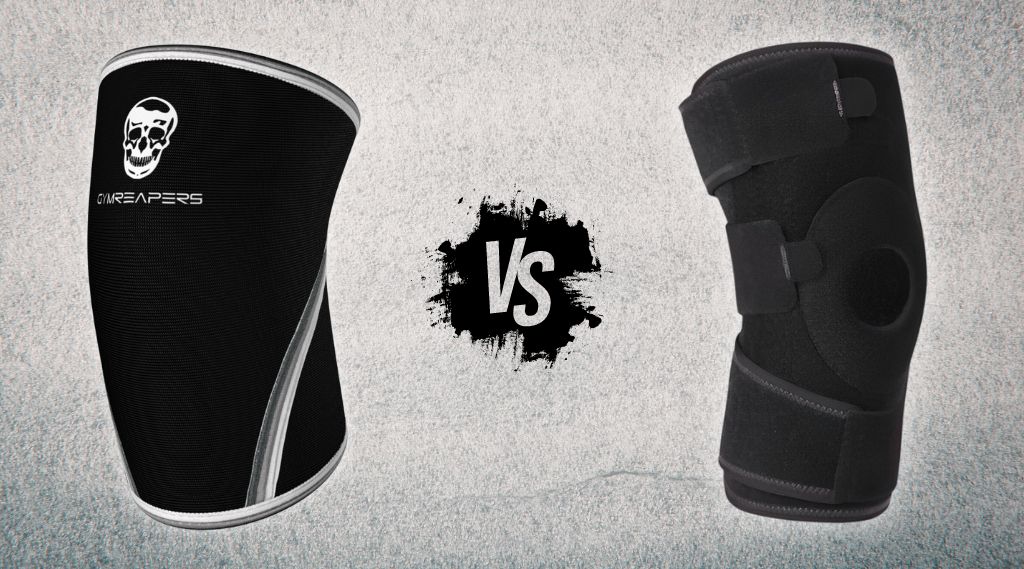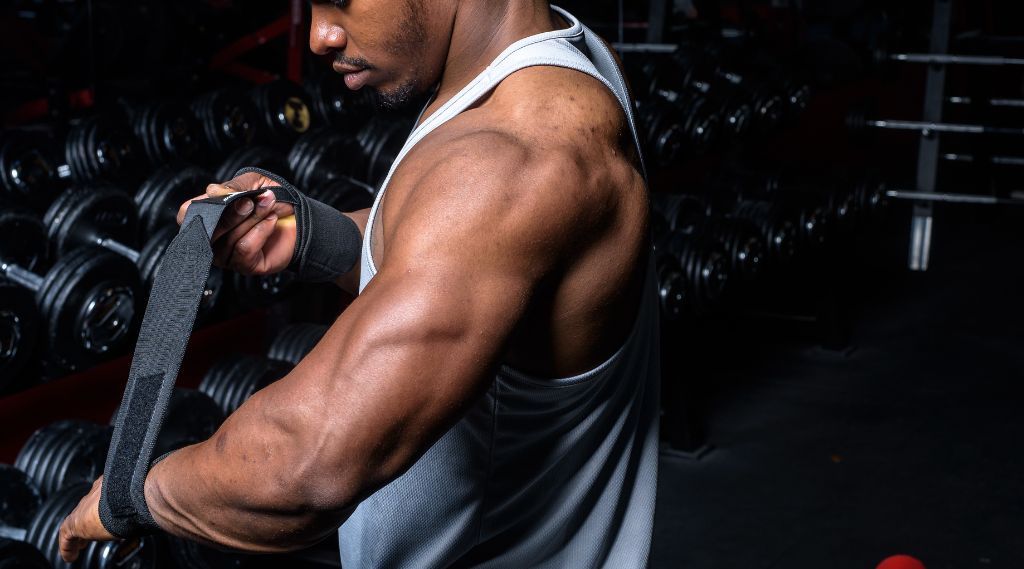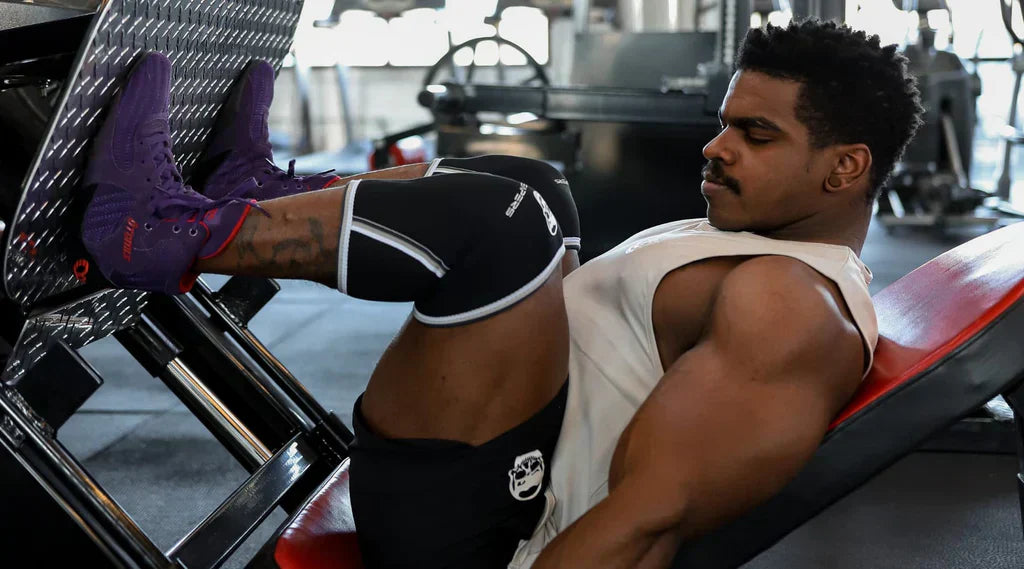If your knees are feeling beat up, you may be wondering about the differences between knee braces and knee sleeves, and which is a better option.
The primary difference between a knee sleeve and a brace is that a knee sleeve is a proactive tool for strength athletes to help prevent injuries by providing compression, stability, and awareness. Whereas a knee brace is a reactionary tool that is generally used for recovery from knee injuries.
While the two may seem interchangeable, they are designed for different purposes.
To help you determine which type of knee support you need, I’ll discuss the differences between knee sleeves and knee braces, their benefits, and their potential drawbacks.
Key Takeaways
What Are Knee Sleeves?

Knee sleeves are typically made out of two pieces of neoprene material that are stitched together. They are designed to slip on and fit snugly over the knee joint.
Knee sleeves provide compression, warmth, and support to the knee while lifting. Knee sleeves are generally used for heavier compound movements like squats and deadlifts, but they can also be used for accessory work like lunges, step-ups, and leg presses.
Knee sleeves come in a variety of thicknesses, but the most common styles are 5mm or 7mm thick.
Thicker sleeves provide more support and compression, and are often a powerlifter’s preferred choice, whereas CrossFit athletes or Olympic lifters may prefer a more lightweight, flexible sleeve that offers less support but allows for more mobility.
What Are Knee Braces?
Knee braces are a more heavy-duty kind of knee support product that is typically designed for postoperative recovery, rehabilitation from injury, and pain management.
Knee braces aim to ease pain and swelling and reduce the risk of re-injuring the joint by providing functional stability and compression that protects the knee from higher-risk positions and movements.
There are a variety of different designs available so that you can choose a brace that is specific to the type of injury and condition being treated. Some may allow weight to be offloaded from the knee, while others eliminate all movement at the knee or limit movement to a specific range.
4 Differences Between Knee Sleeves vs Knee Braces

Support
Knee sleeves are a slip-on compression piece that is made of a neoprene fabric material. As such, they offer light-to-moderate support (depending on the thickness) and store potential energy that helps to boost you out of the bottom of a squat.
In contrast, a knee brace is a bulkier piece of medical equipment that is used primarily to protect a knee from further injury or damage. They provide much greater support but do not offer performance-enhancing benefits similar to knee sleeves.
Ease of Use
A knee sleeve is much easier to use when compared to a knee brace. Knee sleeves simply slide on, are easy to get measurements for, and can fit under or over clothing.
On the other hand, knee braces typically take much longer to put on and take off. They are made of bulky metal and plastic materials and have a variety of velcro straps to ensure they are properly secured.
Additionally, knee braces are much too bulky to fit under most items of clothing, and will typically require a medical professional to fit them properly to your limb.
Mobility and Comfort
Knee sleeves are much more comfortable, and allow for more mobility at the knee joints. Most knee sleeves do not impair your joint’s range of motion (as long as they fit properly). In fact, they can enhance your range of motion as they warm up your joint and encourage joint lubrication.
In contrast, knee braces are much less comfortable. Even athletic knee braces, which allow athletes to still compete and play their sports, are very cumbersome compared to knee sleeves.
This is primarily due to their different functions and levels of support. People will wear a knee sleeve to augment their joint’s natural ability, but will typically wear a knee brace to immobilize or limit a joint’s natural movement to prevent injury and enhance stability.
Versatility
A final difference between knee sleeves and knee braces is their versatility. Knee sleeves can be used in a variety of sports and for a variety of purposes.
They are lightweight, flexible, and can often solve a bunch of different aches and pains (but not injuries) someone may experience in their knee.
In contrast, knee braces are not very versatile at all. They are very specific pieces of medical equipment that often serve to solve a specific injury or problem in one or both knees. They are highly circumstantial, and often only serve one purpose.
Knee sleeves (assuming similar leg circumferences) are universal; a friend can borrow my knee sleeves and will receive almost the exact same benefits as me.
However, the same is not true for a knee brace, and that same friend will likely need to consult a medical professional and get their own brace to solve their specific issue.
Lastly, knee sleeves are more likely to be approved in a broader array of competitions. Knee sleeves can be used in powerlifting, strongman competitions, CrossFit, Olympic Lifting, and even non-strength-based sports like running or football.
The opposite is true for knee braces. These are pieces of equipment that are not approved for powerlifting, and will often require special approval for most other sports.
Knee Sleeves

Benefits
- Injury Prevention: Knee sleeves can help prevent injuries by providing support and compression to the knee joint during exercise.
The compression serves to provide functional support during movement, which is very helpful when lifting heavy and applying frequent pressure to your knees.
This compression can therefore help reduce swelling and minimize pain. Lots of general aches in a knee can usually be alleviated by a well-fitting knee sleeve.
-
Joint Temperature: The compression provided by knee sleeves can help improve blood flow to the knee joint, which can aid in your ability to perform sets.
Knee sleeves trap the heat in your joint and keep your knee joint and the local muscles surrounding it warm when you have longer rest periods. This is an especially common helpful benefit in powerlifting and strongman style training, which both require longer rest periods.
-
Encourages Better Technique: The compression from knee sleeves provides support and slight pressure to keep the joint stable and in the right position, especially under heavier loads.
-
Increased Stability and Performance: Knee sleeves can help improve the stability of the knee joint during exercise, which can help improve technique, reduce the risk of injury, and boost your confidence, all of which lead to better performance.
While the overall benefit of a knee sleeve (in terms of enhancing your ability to lift more weight) may be more mental than physical, many lifters do report being able to squat a heavier load with their knee sleeves as opposed to when squatting with naked knees.
- More User Friendly: Unlike a knee brace, knee sleeves are very easy to use and much easier to size properly. They are also much easier to maneuver in than a knee brace.
- Versatility: Knee sleeves can be used in a diverse range of exercises, including any squat movement, deadlifts, or even running and jumping movements.
Drawbacks
-
Limited Support: While knee sleeves do provide some support to the knee joint, they are not as supportive as knee braces.
Knee sleeves will offer a good amount of support for lifting weights, but they are not supportive enough to manage an existing injury.
-
Costs: Knee sleeves are a fairly expensive piece of equipment. Most brands charge between $80-$110, and this is a cost that will likely be incurred every 2-3 years to replace them (if you use them once or twice a week).
- Cumbersome: Knee sleeves can be very hard to put on when your legs are sweaty, especially if you're not using the proper technique.
Who Should Use Knee Sleeves

- Lifters That Want To Improve Their Squat: Knee sleeves are a good option for athletes who require moderate support and compression for their knees during exercise. Again, knee sleeves will not help you lift a ton more weight, but definitely a bit more.
- Lifters With Past Injuries: Knee sleeves are particularly beneficial for athletes who have had knee injuries in the past or are at a higher risk of knee injury due to their sport or training regimen.
Knee sleeves should not be used by athletes with a current knee injury without being advised to do so by a physiotherapist, but can be very useful for athletes with past injuries that flare up or that can get stiff or achy when they are cold.
- Most Powerlifters: Raw powerlifting is currently the most popular form of powerlifting, and knee sleeves are an approved piece of equipment (provided your federation approves of the brand you wear).
How To Wear Knee Sleeves Properly

Follow these 3 tips to ensure you’re wearing your sleeves properly:
Tip #1: Ensure that the sleeve is the correct size and fits snugly over the knee joint.
Most manufacturers will post sizing guides with specific measurements, so I recommend taking the time to look these over.
Some lifters will purposely size down to get a more compressive fit, and potentially gain some strength benefits; however, I recommend against this if you’re only buying one pair of sleeves.
Sizing down will only make you uncomfortable, make the sleeve harder to get on, and will likely reduce the longevity of the sleeve as the stitches in the seams will start ripping sooner.
However, this isn’t as much of an issue if you’re buying two pairs; a regular pair for training and a tighter pair for competition.
Tip #2: Learn to put them on properly.
Here’s an easier way to put on your sleeves:
- At the bottom of your leg, near your ankle, fold the top end of the knee sleeve down to the halfway point.
- Next, grab the bottom of the sleeve and fold it up until it reaches the crease made in your first fold. It should now be folded into thirds.
- Grab the knee sleeve by the bottom, and pull it up your leg to the knee joint. To help this process, try wearing long socks or leggings to reduce friction. This will also reduce the amount of leg hairs pulled out.
- Position the sleeve so that it covers the entire knee joint, with the top of the sleeve sitting just above the kneecap.
- Unfold the knee sleeve to cover your entire knee.
- Adjust the sleeve as needed to ensure that it is comfortable and does not restrict movement.
Tip #3: Don’t Become Too Reliant
Although knee sleeves are an excellent tool, you don’t want to get to the point where you feel you’re unable to move without them.
For this reason, I recommend that you do most of your warm-up sets without your sleeves on, and put them on for your last warm-up or top-sets.
Another suggestion is to wear them only for heavier compound lifts and consider taking them off for accessory movements like lunges, step-ups, leg extensions, hamstring curls, etc..
Knee Sleeve Recommendations

The best knee sleeve for general lifting or powerlifting is the GymReapers 7mm knee sleeve. As mentioned above, these sleeves are IPF approved, offer great compression and durability, and come with a 1-year replacement guarantee should you have any issues.
Knee Braces
Types & Their Benefits
There are four main types of knee braces, and they each have a different primary benefit. The four main types and their benefits are:
These are most commonly used for those with knee osteoarthritis.
Drawbacks
- Bulky: Knee braces are quite bulky because they serve to restrict the movement of your knee joint so that it has time to heal completely; therefore, they need to be made out of heavier, bulkier, and more supportive material.
- Costly: While knee sleeves are costly in their own right, knee braces are typically much more expensive. This may depend on the purpose of your brace and its respective materials, but they are almost always more expensive than a knee sleeve.
On the bright side, a knee brace will likely be covered under your healthcare plan if it is prescribed to you by a medical professional due to a serious injury.
- Reactionary: As mentioned above, a knee brace is often thought of as more reactionary than a knee sleeve. Generally, people wear knee sleeves as a proactive tool to avoid major injury, and must only resort to a brace once a serious injury has occurred (which is most commonly associated with surgery to repair the damage).
Who Should Use A Knee Brace
While the general rule of thumb is that knee sleeves are proactive, and braces are reactive to injuries, I recommend that a knee brace should only be used by someone after consulting with a medical professional.
As noted above, there are a variety of different types of braces, and they each have distinct advantages and drawbacks.
The best way to determine which knee brace support is best for your condition is to discuss this topic with your doctor, physiotherapist, or other medical professional.
How To Wear A Knee Brace Properly
Instructions on how to wear a knee brace properly are best sought through whichever medical professional instructed you to buy one.
You are most likely wearing a knee brace due to a specific injury that you have incurred, and that brace is most likely designed for your specific circumstances and your specific dimensions.
As such, I recommend seeking professional advice to ensure that you are wearing your brace properly and in a manner that is fulfilling its purpose.
Frequently Asked Questions
What is better, a knee brace or a knee sleeve?
Compression knee sleeves and knee braces are two different things that serve different purposes, so neither is “better” than the other. Braces are great for situations where you are rehabbing a major injury and want to protect the joint, but sleeves are great for augmenting your squat and helping you move freely.
Is a knee sleeve considered a brace?
While not technically a knee “brace”, a knee sleeve offers support while strengthening the muscles and joints. You can treat joint pain with knee sleeves available in a variety of sizes and designs. They are distinguished from braces most commonly because they are more lightweight and have no mechanical elements.













Leave a comment
All comments are moderated before being published.
This site is protected by hCaptcha and the hCaptcha Privacy Policy and Terms of Service apply.